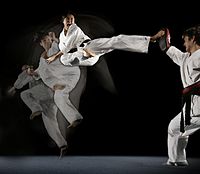Kicks (Chagi)[edit]
Main article: Kick
All kicks can be executed as jump kicks, spin kicks, jump spin kicks or multi-rotational spin kicks. Also, all can be performed by the front or rear leg in a given stance.
Some of the best-known Taekwondo kicks include:
- Front Kick (앞 차기 ap chagi): This is a very linear kick. The practitioner raises the knee to the waist, pulls the toes back and quickly extends the foot at the target. It is also known as the snap kick. The front kick is one of the first kicks learned in taekwondo; if mastered it can become one of the most powerful. This technique is more meant to be used to push the attacker away, but can injure the opponent as well.
- Side kick (옆 차기 yeop chagi): A very powerful kick, in which the practitioner simultaneously raises the knee and rotates the body 90 degrees, while extending their leg. In WTF style taekwondo, this technique should strike with the outside edge of the foot, although using the heel may provide more force if used in sparring.
- Roundhouse kick (돌려 차기 dollyeo chagi): The practitioner raises the knee, turns the hips, pivots on the non-kicking foot, and snaps the kick horizontally into the target at an 80 to 90-degree angle, either with the instep or with the ball of the foot with the toes pulled back.
- Back kick (뒷 차기 dwit chagi): The practitioner turns the body away from the target and pushes the back leg straight toward the target, hitting it with the heel while watching over the shoulder. The turning motion helps to give this kick a lot of power. Without proper care, you can "spin out" and lose your balance from using this attack.
- Reverse side kick (반대 옆 차기 bandae yeop chagi): This kick is similar to the back kick, except the body turns further, allowing the heel to hit the target with the foot pointing to the side as in a regular side kick, instead of downward as in a true back kick.
- Hook kick (후려 차기 huryeo chagi): A less popular kick traditionally, however it has found increasing favor in modern competitions. The practitioner raises the knee in a fashion similar to the roundhouse kick, then extends the foot outward then snaps it around in a dorsal arc, with the heel as the intended striking weapon.
- Axe kick (내려 차기 naeryeo chagi): Another kick that has increased in popularity due to sparring competitions. The leg is raised usually from the outside of the body like an outside crescent kick. then the leg is pulled down with the heel pointed downward. It is typically targeted toward the head, shoulder, or chest and requires significant flexibility to employ effectively. This kick is best used against the collar bone, which can readily break from this attack. the setup in the initial raise of the kick can also be done from the inside, or middle (straight up and down.) Crescent kick (an chagi/bakkat chagi): There are two variations of this kick: the outer crescent and the inner crescent. In the outer, the practitioner raises the extended leg as high as possible, and slightly up across the body, (a bit across the centerline of the body), then sweeping outward to the side, in a circular movement. In the inner, the motions are the same but the direction of the kick changes, this time originating from the outside of the body, heading towards the inside, or centerline of the body. These kicks are also called "inside crescent kick" and "outside crescent kick" at some taekwondo schools.
- Spin kicks (반대 돌려 차기 bandae dollyeo chagi): There are several spinning kicks that involve the rotation of the entire body and head before the kick is released. Spinning kicks include the back pivot kick (dweel chagi), spinning hook kick (dweel huryeo chagi), spinning axe kick, returning kick, 360 turning kick, and a number of other kicks of varying popularity.
- Tornado kick (on mondollyo chagi):The practitioner steps forward and spins in the direction of their back leg while raising their knee and jumping to perform a spinning inside crescent kick in midair.
- Jump Kicks (뛰어 차기 ttwieo chagi):
There are also many kicks that involve jumping before their execution. These include the jumping front kick (ee dan ap chagi), jumping side kick (이단 옆 차기 idan yeop chagi), flying side kick, jumping axe kick, jumping roundhouse (ee dan dollyeo chagi), jumping spinning hook kick, jumping spinning roundhouse kick, jumping back kick, and jump spinning side kick. Normally, jumping kicks involve pulling up the back leg to help gain height during the jump and then performing the kick itself with the front leg.
- Advanced kicks: There are a variety of kicks that can be used in combination or stem out from a simple kick to create more difficult ones. Some of these include 540 Kick (One spins 1½ times in mid-air and does a kick, usually a back spinning hook kick), a 720 Kick (the practitioner spins 2 times in mid-air and performs a kick, usually a back spinning hook kick), and Triple Aero Kicks (Practitioner performs round house kick, back spinning hook kick, and another round house kick in mid-air).
- Fast Kicks: Also, many kicks can be employed using a fast kick style. The practitioner shuffles the back leg forward to the front leg, and the front leg comes up and kicks closer to the enemy than the practitioner had been before execution. This can be used with side kick, roundhouse kick, front kick, hook kick, and axe kick.


No comments:
Post a Comment